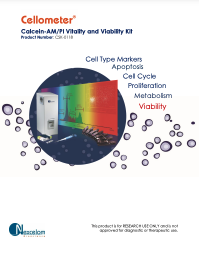Cellometer Calcein-AM / PI Vitality / Viability
Calcein AM (Calcein acetoxymethyl ester) is a cell permeable, non-fluorescent compound. Upon crossing the cell membrane, Calcein AM is rapidly hydrolyzed by cellular esterases inside live cells. The hydrolysis cleaves the AM group, converting the non-fluorescent Calcein AM to a strongly green fluorescing Calcein. The more hydrophilic Calcein is trapped inside the cell (1). Cells that do not possess active cytoplasmic esterases are unable to convert Calcein AM to Calcein, and therefore do not fluoresce green. This allows for a quick and easy detection of metabolically-active cells in a sample.
Stains such as propidium iodide (PI), 7-AAD, and ethidium bromide (EB), are membrane exclusion dyes that are frequently used to stain non-viable nucleated cells with compromised membranes. Acridine orange freely diffuses across the cell membrane and stains DNA in all nucleated cells. When AO and PI are combined it is possible to determine % viability for nucleated cells. When Calcein AM is used in conjunction with PI, it is possible to determine % vitality / viability based on the number of metabolically-active (green fluorescent) and non-viable (red fluorescent) cells in a sample.
Since Calcein AM does not require DNA binding, it stains all metabolically-active cells and can be used to measure metabolic activity in non-nucleated cells, such as platelets (4). Calcein-AM is also a good alternative for analysis of adipocytes, as the AO dye has shown some non-specific binding of lipid
droplets that does not occur with Calcein AM (5). Because Calcein AM is photostable, shows low cytotoxicity, does not affect cellular functions, and requires cellular esterases for conversion to greenfluorescing Calcein, it is a popular stain for the examination of cell vitality and viability. (1,2,3).
- Braut-Boucher, F. et al. Journal of Immunological Methods. Vol. 178, Issue 41 (1995).
- Luc S. De Clerck. et al. Journal of Immunological Methods. Vol. 172, Issue 1, (1994).
- Parish, CR. Immunology and Cell Biology. Vol. 77 (1999)
- Verheul , HW. et al. Blood. Vol. 96 No. 13 (2000)
- Kilroy, G. et al. PLoS One. Vol.4, Issue 9 (2009)

